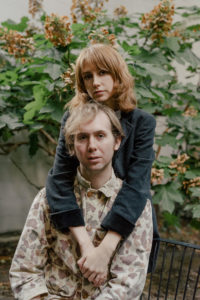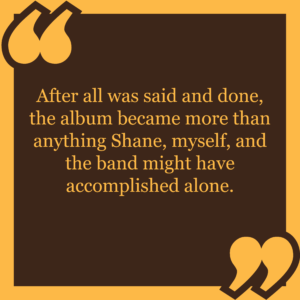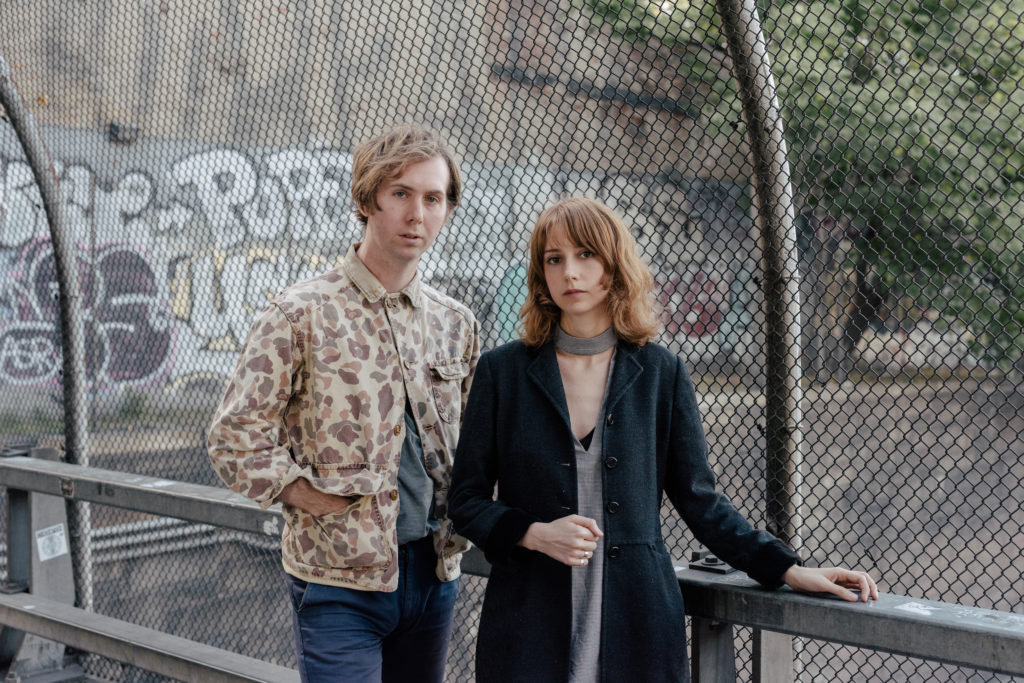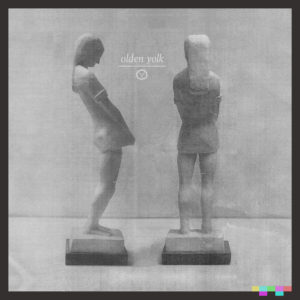
As a concept, Olden Yolk has been in existence since 2012. The brainchild of songwriter Shane Butler, the project’s current artistic path wasn’t paved until 2016 after he met and formed a collaboration with Caity Shaffer, a songwriter herself. Both multi-instrumentalists and sharing a love for “choral compositions,” the duo began writing and divvying up vocal duties, ultimately coming together in the studio to cut their self-titled debut, which was released in February on Trouble in Mind. (Our review can be read here.)
We recently sat down with Butler and Shaffer to discuss where they’re looking to expand on their cooperative sound in the future, why the album is a gateway to their live show, and what impact is felt on their music by marrying it with visuals.
TrunkSpace: Your debut album dropped a few weeks ago. What emotions were you two wrestling with as you geared up to launch such a big part of who you are creatively, both as individuals and as a pair, into the world?
Butler: Honestly, I’m personally just really looking forward to bringing the record to people. I have a lot of excitement to tour and to offer what we’ve gathered to the world outside. Also, I have a lot of excitement already to jump back in the studio and make another album after gathering experience touring these songs.
TrunkSpace: From what we read, the idea for Olden Yolk first hit in 2012, but it didn’t become the dynamic duo that it is today until a few years later. How has the band changed sonically from what you were in the beginning to what we hear today on your debut?
Butler: Well, in actuality the project didn’t really become a duo until this past year, 2017. Between 2013 to 2014, I recorded a split-album with our friend Weyes Blood, but at that point Olden Yolk was still a ‘solo’ entity. Caity & I met in 2016 and started to share a lot of ideas with each other and towards the beginning of 2017 we started working on this album together. It’s been super exciting; the opportunity to incorporate multiple voices, songwriting styles, and work with a partner has really expanded the project. The sound will probably always be changing – so this specific album is just one incarnation of that teamwork between Caity & I, as well as with Jesse (DeFrancesco) & Dan (Drohan) who added to the record.
TrunkSpace: Your vocals pair so well together. Did that marrying of your voices work instantly when you two first started playing together or did it take some perfecting?
Shaffer: Thank you. We’re both fans of choral compositions, and/or songs with multiple singers, so we made something we might want to listen to – something conversational. It was our first point of connection, musically. While demoing, I added some accompanying vocals to “Common Ground,” and the result excited us, so vocal interplay became a major focus from that point forward.
Butler: Very nice you say that. That’s one of the things that first got me really excited about collaborating together. When Caity and I started singing together it really was a breakthrough moment. I think the timbre of our voices are really nice compliments to each other, or at least what I’d like to listen to. When we figured out weaving moments on songs such as “Common Ground,” “Esprit De Corps” and “Takes One To Know One,” I was pretty excited. Also, listening back to that stuff just shows me how much more we can do with that idea in the future. We really want to push that stuff on the next album.
TrunkSpace: One of the things we loved about your debut was that while a studio album, we felt it was also a great window into what an Olden Yolk live show would sound like. Was that one of the goals with the album, trying to capture a live vibe?
Butler: Well, it was definitely important to do that on some level. For one thing we really wanted to have an album where we could play the entire thing live. I’ve been part of albums in the past where there are studio songs that you literally just can’t play live… and it’s a bummer. So, after all the demos were done we went into the studio to just rehearse and make sure we could capture a live essence of all the songs. This also allowed the ability for new parts and subtleties to be added to the songs. I think this was a time when Jesse was really able to come up with some great guitar lines and ambiances for certain songs to add to the arrangements that were already there. Almost every song on the album had it’s core played live by the band in the room and then we went back in and added to those original arrangements afterward. But, a lot of the sound on the album is from those first takes – the core of the songs were all live. It definitely helps to provide a gateway between the studio and the live show.
TrunkSpace: When you put the finishing touches on the album and called it a wrap, did the experience of putting it together exceed your expectations? Did you accomplish all that you set out to with it and more?
Butler: Yes and no. I think we were all really happy with the album, but as always happens, as soon is it was done I think we realized how much further we could go on the next album. I think this is actually a really healthy feeling. I feel like if you ever were to finish an album and say, “That’s it, we did it – this is the best thing we could ever make,” it’s like you would die as an artist. I think that constant want to improve and the knowledge that you can push yourself further is what keeps you alive as an artist.
Shaffer: Completely agree with Shane. After all was said and done, the album became more than anything Shane, myself, and the band might have accomplished alone. We had a lot of talented people lending their insight – Jon Nellen, Jarvis Taveniere and more – who enlivened the songs. Compositionally, we were coming to terms with our sound, and that’s what I hear. While I’m glad to have that process captured on the record, there’s a lot more we’re looking forward to.

TrunkSpace: Do you need to step away after completing a project like your debut in order to refuel the creative tank or does the process inspire you to jump right into the next chapter of your artistic journey?
Shaffer: I’m feeling ready to jump into the next thing. We’ll be playing a few recent songs on our upcoming tour, and otherwise have a stockpile of ideas. In some ways, releasing the album refueled the creative tank. Receiving positive feedback from friends is definitely motivating to me, as is listening to the songs on the album and having those “what if”/“next time” thoughts.
Butler: A little bit of both. Personally I’m really excited to play all these songs live throughout this year. I always learn so much from performing live and get ideas for what directions to bring the next set of songs from this process. For me, touring is an essential part of the writing process – it’s where you gather the notes you will use in the next stage of creation. Also, I’ve always experienced that a lot of songs come to me when I’m traveling, so I’m excited to be writing a lot while traveling this year – and getting a little break from being stationary.
TrunkSpace: You’re both songwriters. How does that impact the writing process for Olden Yolk? What does that process look like from the inception of an idea to the completion of a song?
Butler: It’s really different for every song on the album. Both Caity & I have a hand in every song that’s on the album although there are songs that one of us may have created the core for and vice versa. We always do a lot of workshopping for each thing and then bring it into a phase where we can just freeform and play with it a bit in the studio. Also, we have had helping hands from our bandmates Jesse & Dan and from other friends who have added flourishes and arrangements to the songs. Each song is it’s own organism with dynamic traits. We’re both really excited to push the boundaries of the collaborative process on the next album. There’s so many ways to do, so…
Shaffer: Yes, for the next album, we want to try to begin that collaborative stage a bit earlier – working on new songs at the formative stage of the writing process as opposed to the end. Just for kicks, to free things up.
TrunkSpace: We could be completely off base here, but it seems like you enjoy the process of marrying visuals with your music. Is that a continuation of your creative expression with the music itself, or does that tap into a completely different part of your artistic brain?
Butler: The blending of visuals and music has always been really important to me. I studied visual art and have pursued it alongside my music for a long time now. With this project we’ve really wanted to really have fun with our visual ideas and to test out what happens when we place the music alongside certain images. It’s a place where we’ve been able to bring together these two practices. It’s really incredible how much of an effect it can have. A lot of my favorite bands over the years have had a really strong connection to the visual arts and I look to them for inspiration. There is such a long history of visual artists making music and vice versa. Everything from Fluxus to La Monte Young to The Velvet Underground to Sonic Youth to Black Dice to Grimes and onward…
 TrunkSpace: Where are you both hardest on yourselves as artists?
TrunkSpace: Where are you both hardest on yourselves as artists?
Butler: There are weeks where you feel that you are really on and that you are heading in the right direction and then there are weeks where you feel like you should just give up and never make anything again. Trying not to get stuck in the latter is the hardest thing. I’m so thankful to have supportive folks in my life and to have some inner-practices which have helped me continue forward.
Shaffer: Yeah, the existentialism bit is real. Outside of that – I’ve been hard on my voice, been surprised by it many times, asked myself what the hell it’s doing, felt like it wasn’t in my control. When nervous I slip into a British accent, and there’s just no need for that. My voice has a lower range, but that’s something I’m embracing – I see it more like a birthmark and less like a wart these days.
TrunkSpace: If your debut launched Olden Yolk into the fame stratosphere, would you be comfortable being cast in that bright of a spotlight? Is there a downside to sharing your art with the world?
Shaffer: I can’t see a real downside. The infrequent criticism/reviews might seem dark, but I think dealing with that builds character, not to mention that sometimes the criticism is spot on. Overall, we’re lucky that people are listening. Also, it is difficult to find a supportive label. We’re grateful for ours. Bill and Lisa (Trouble in Mind) are kindred spirits and we admire them a lot. Regarding spotlight casting, I enjoy a certain degree of anonymity that I am probably unwilling to part with. The reason I share is because I’ve benefited so much from others doing the same… but it took a while.
Butler: I can’t imagine a life where I didn’t have some semblance of anonymity and I don’t think I would like it if I didn’t have that. I would be very happy for our work to reach as many people as possible – yet, I would always like to maintain a ‘regular life’ along with that. I also really want to keep growing as an artist. I know that a lot of demands are placed upon those who have had a lot of success and it has been hard at times for them to change, grow, and push their art to another level because they have already become so successful at one thing. It probably takes an incredible amount of discipline and fearlessness to keep yourself growing once you’ve found a ‘formula that works’. Luckily there are people who have always pushed themselves in light of these things – if our work was ever to be held in a light like that – I would look to these people for inspiration/guidance.
Olden Yolk’s self-titled debut is available now on Trouble in Mind.


